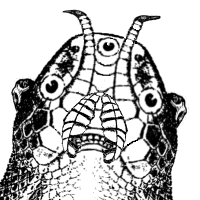 There is clearly a close relationship between consciousness and language. The ability to conduct a conversation is commonly taken as the litmus test of human-style consciousness for both computers and chimpanzees, for example. While the absence of language doesn’t prove the absence of consciousness – not all of our thoughts are in words – the lack of a linguistic capacity seems to close off certain kinds of explicit reflection which form an important part of human cognition. Someone who had no language at all might be conscious, but would they be conscious in quite the same way as a normal, word-mongering human?
There is clearly a close relationship between consciousness and language. The ability to conduct a conversation is commonly taken as the litmus test of human-style consciousness for both computers and chimpanzees, for example. While the absence of language doesn’t prove the absence of consciousness – not all of our thoughts are in words – the lack of a linguistic capacity seems to close off certain kinds of explicit reflection which form an important part of human cognition. Someone who had no language at all might be conscious, but would they be conscious in quite the same way as a normal, word-mongering human?
It might therefore seem that when Jordan Zlatev asserts the dependence of language on consciousness, he is saying something uncontroversial. In fact, he has both broader and more specific aims: he wants to draw more attention to the relationship on the one hand, and on the other readjust our view of where the borders between conscious and unconscious processes lie.
It seems pretty clear that a lot of the work the brain does on language is unconscious. When I’m talking, I don’t, for example, have to think to myself about the grammar I’m using (unless perhaps I’m attempting a foreign language, or talking about some grammatical point). I don’t even know how my brain operates English grammar; it surely doesn’t use the kind of rules I was taught at school; perhaps in some way it puts together Chomskyan structures, or perhaps it has some altogether different approach which yields grammatical sentences without anything we would recognise as explicit grammatical rules. Whatever it does, the process by which sentences are formed is quite invisible to me, the core entity to whom those same sentences belong, and whose sentiments they communicate. It seems natural to suppose that the structure of our language is provided pre-consciously.
Zlatev, however, contends that the rules of language are social and normative; to apply them we have to understand a number of conventions about meanings and usage; and whatever view we may take of such conventions their use requires a reflective knower (Zlatev picks up on a distinction set out by Honderich between affective, perceptual, and reflective consciousness; it’s the latter he is concerned with). To put it another way, operating the rules of language requires us to make judgements of a kind which only reflection can supply, and reflection of this kind deserves recognition as conscious. Zlatev is not asserting that the rules of grammar at work in our brain are consciously know after all: he draw a distinction between accessibility and introspectability; he wants to say that the rules are known pre-theoretically, but not unconsciously.
Perhaps we could put Zlatev’s point a different way: if the rules of language were really unconscious, we should be incapable of choosing to speak ungrammatically, just as we are incapable of making our heart beat slower or our skin stop sweating by an act of will. Utterances which did not follow the rules would be incomprehensible to us. In fact, we can cheerfully utter malformed sentences, distinguish them from good ones and usually understand both. Deliberate transgressions of the rules are used for communicative or humorous effect (a rather Gricean point). While the theory may be hidden from introspection, the rules are accessible to conscious thought.
If the rules of language were unconscious, asks Zlatev, how would we account for the phenomenon of self-correction, in which we make a mistake, notice it, and produce an emended version? And how could it be that the form of our utterances is often structured to enhance the meaning and distribute the emphasis in the most helpful way? An unconscious sentence factory could never support our conscious intentions in such a nicely judged way. Zlatev also brings forward evidence from language acquisition studies to support his claim that unconscious mechanisms may support, but do not exhaust, the processes of language.
At times Zlatev seems to lean towards a kind of Brentano-ish view; language requires intentionality, and nothing but consciousness can provide it (alas, in a way which remains unexplained). Intriguingly, he says that he and others were deceived into accepting the unconsciousness of language production at an earlier stage by the allure of connectionism, whose mechanistic nature only gradually became clear. I think connectionists might feel this is a little unfair, and that Zlatev need not have given up on connectionist approaches to reflective judgement simply because they are ‘mechanistic’.
All in all, I think Zlatev offers some useful insights; his general point that a binary division between conscious and unconscious simply isn’t good enough is indeed a good one and well made. I wonder whether this is a point particular to the language faculty, however. Couldn’t I make some similar points about my tennis-playing faculty? Here too I rely on some unconscious mechanisms, and couldn’t tell you exactly which arm muscles I used in which way. Yet making my hand twist the racquet around and move it to the right place also seems to require some calculated, dare I say reflective, judgements and the way I do it is exquisitely conditioned by tactics and strategy which I devise and entertain at a fully self-conscious level.
Be that as it may, it’s bad news for the designers of translation software if Zlatev is right, since their systems will have to achieve real consciousness before they can be perfected.


 I was reading somewhere about SETI and I was struck by the level of confidence the writer seemed to enjoy that we should be able, not only to recognise a signal from some remote aliens, but actually interpret it. It seems to me, on the contrary, that finding the signal is the ‘easy problem’ of alien communication. We might spend much longer trying to work out what they were saying than we did finding the message in the first place. In fact, it seems likely to me that we could never interpret such a signal at all.
I was reading somewhere about SETI and I was struck by the level of confidence the writer seemed to enjoy that we should be able, not only to recognise a signal from some remote aliens, but actually interpret it. It seems to me, on the contrary, that finding the signal is the ‘easy problem’ of alien communication. We might spend much longer trying to work out what they were saying than we did finding the message in the first place. In fact, it seems likely to me that we could never interpret such a signal at all.
 Well, I don’t think anyone underestimates the scope of the task, but you know it can hardly be impossible. For example, we send off a series of binary numbers; binary is so fundamental, yet so different from a random signal, that they would be bound to recognise it. The natural thing for them to do is echo the series back with another term added. Once we’ve got onto exchanging numbers, we send them, like say 640 and 480 over and over. If they’re sophisticated enough to send radio signals, they’re going to recognise we’re trying to send them the dimensions of a 2d array. Or we could go straight to 3D, whatever. Then we can send the bits for a simple image. We might do that Mickey Mouse sort of picture of a water molecule: odds are they’re water-based too, so they are bound to recognise it. We can get quite a conversation on chemistry going, then they can send us images of themselves, we can start matching streams of bits that mean words to streams of bits that mean objects, and we’ll be able to read and understand what they’re writing. OK, it’ll take a long time, granted, because each signal is going to take years to be delivered. But it’s eminently possible.
Well, I don’t think anyone underestimates the scope of the task, but you know it can hardly be impossible. For example, we send off a series of binary numbers; binary is so fundamental, yet so different from a random signal, that they would be bound to recognise it. The natural thing for them to do is echo the series back with another term added. Once we’ve got onto exchanging numbers, we send them, like say 640 and 480 over and over. If they’re sophisticated enough to send radio signals, they’re going to recognise we’re trying to send them the dimensions of a 2d array. Or we could go straight to 3D, whatever. Then we can send the bits for a simple image. We might do that Mickey Mouse sort of picture of a water molecule: odds are they’re water-based too, so they are bound to recognise it. We can get quite a conversation on chemistry going, then they can send us images of themselves, we can start matching streams of bits that mean words to streams of bits that mean objects, and we’ll be able to read and understand what they’re writing. OK, it’ll take a long time, granted, because each signal is going to take years to be delivered. But it’s eminently possible. Knud Thomsen has put a
Knud Thomsen has put a